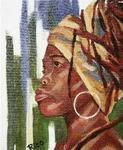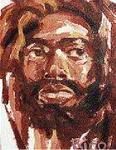Postcards from 'Paradise'
published: Sunday | October 26, 2008


'Miss Ifrica' (left) and 'Buju III'.
Michael Robinson, Gleaner Writer
KASPAR DEECHE is a German photographer whose images read like postcards from a world tour. His black-and-whites are bits of life in all its universal beauty. A group of nuns, a man fishing and the sun rising in Portland are a few of Deecke's chosen subjects.
Rico Art is a Japanese painter with a lover's awareness of this land of wood and water. Her sojourn here, originally inspired by a curiosity about Jamaica's indigenous music, has been a powerful muse. Brightly coloured images of children carrying water and walking to school hang beside portraits of children of Rastafari, Buju Banton being the most famous among them.
Good complement
Rico's bright, almost primary colours are a good complement for Kaspar's pictures. The former has moments of monochrome, while the latter sometimes dabbles in colour with small digital touches. Together, their work is the substance of <span style="font-weight: bold">'Strangers in Paradise', the exhibit now mounted at Gallery Pegasus</span>. Their individual perspectives, informed by two very different cultures, make for interesting viewing as they filter and recreate the world we all experience.
For his part, Deecke takes a lot of photos of architecture - old brick walls and modern skyscrapers. In 'Port Antonio Scene' and 'Old Man Fishing', the German image-maker gives us two scenes from different countries and it's hard to tell which one is Jamaica. The photographer's eye finds similarities in physical structures and plain old everyday life that are as common as poetry.
His old man could be looking over a seaside wall on this or any other island; his elderly Portland woman could be making her way down a sidewalk in Europe.
The elements Deecke has chosen to include in his compositions give them an intimate universality; the angles and the lighting lend dramatic appeal. His nuns wear two sets of colours as they pass a generic wall painted in similarly contrasting colours. The result is epic and intimate at the same time - like eavesdropping on a confession.
Rico's paintings evince a preoccupation with 'people watching'. Her schoolchildren are oblivious to the observer's presence as they chat at the side of the road or just watch each other (Hanover Street series). Two children hauling water up a hill in real-life Jack-and-Jill style are a quintessential slice of life. Children represent innocence and an appreciation of the simple things. Rico's focus on them reminds us of the simple clarity of perspective shared by many eastern philosophies. Children also embody a country's future.
Favourite subject
Another of Rico's favourite subjects is Rastafari. Portraits such as 'Miss Ifrica' and the Buju series - sometimes painted in one colour - as well as a group of tam-crowned kids in 'Likkle Bredda', are a few examples of her portrayal of I and I. 'Miss Ifrica' is regal and dignified. Buju Banton is iconic. Rico's images are an extension of her appreciation and affinity for a people and a culture borne out of living in Jamaica for nearly two decades.
'Strangers in Paradise' combines the visions of two artists with a unique view of Jamaica. They've adopted this country and clearly share a love for the place. As a result, their art is a fusion of cultures, visions and approaches.
published: Sunday | October 26, 2008


'Miss Ifrica' (left) and 'Buju III'.
Michael Robinson, Gleaner Writer
KASPAR DEECHE is a German photographer whose images read like postcards from a world tour. His black-and-whites are bits of life in all its universal beauty. A group of nuns, a man fishing and the sun rising in Portland are a few of Deecke's chosen subjects.
Rico Art is a Japanese painter with a lover's awareness of this land of wood and water. Her sojourn here, originally inspired by a curiosity about Jamaica's indigenous music, has been a powerful muse. Brightly coloured images of children carrying water and walking to school hang beside portraits of children of Rastafari, Buju Banton being the most famous among them.
Good complement
Rico's bright, almost primary colours are a good complement for Kaspar's pictures. The former has moments of monochrome, while the latter sometimes dabbles in colour with small digital touches. Together, their work is the substance of <span style="font-weight: bold">'Strangers in Paradise', the exhibit now mounted at Gallery Pegasus</span>. Their individual perspectives, informed by two very different cultures, make for interesting viewing as they filter and recreate the world we all experience.
For his part, Deecke takes a lot of photos of architecture - old brick walls and modern skyscrapers. In 'Port Antonio Scene' and 'Old Man Fishing', the German image-maker gives us two scenes from different countries and it's hard to tell which one is Jamaica. The photographer's eye finds similarities in physical structures and plain old everyday life that are as common as poetry.
His old man could be looking over a seaside wall on this or any other island; his elderly Portland woman could be making her way down a sidewalk in Europe.
The elements Deecke has chosen to include in his compositions give them an intimate universality; the angles and the lighting lend dramatic appeal. His nuns wear two sets of colours as they pass a generic wall painted in similarly contrasting colours. The result is epic and intimate at the same time - like eavesdropping on a confession.
Rico's paintings evince a preoccupation with 'people watching'. Her schoolchildren are oblivious to the observer's presence as they chat at the side of the road or just watch each other (Hanover Street series). Two children hauling water up a hill in real-life Jack-and-Jill style are a quintessential slice of life. Children represent innocence and an appreciation of the simple things. Rico's focus on them reminds us of the simple clarity of perspective shared by many eastern philosophies. Children also embody a country's future.
Favourite subject
Another of Rico's favourite subjects is Rastafari. Portraits such as 'Miss Ifrica' and the Buju series - sometimes painted in one colour - as well as a group of tam-crowned kids in 'Likkle Bredda', are a few examples of her portrayal of I and I. 'Miss Ifrica' is regal and dignified. Buju Banton is iconic. Rico's images are an extension of her appreciation and affinity for a people and a culture borne out of living in Jamaica for nearly two decades.
'Strangers in Paradise' combines the visions of two artists with a unique view of Jamaica. They've adopted this country and clearly share a love for the place. As a result, their art is a fusion of cultures, visions and approaches.

Comment